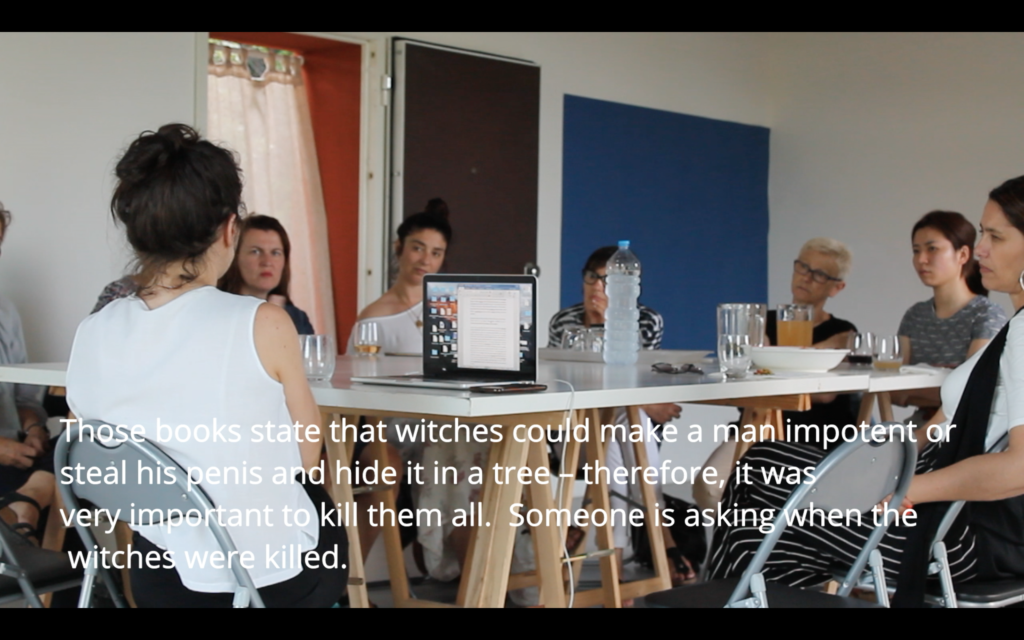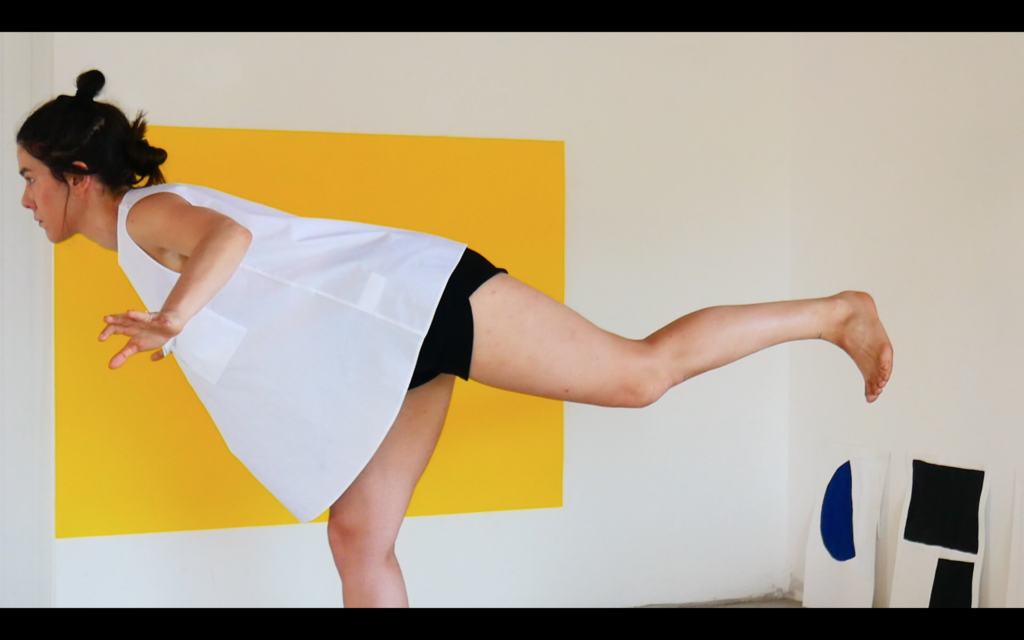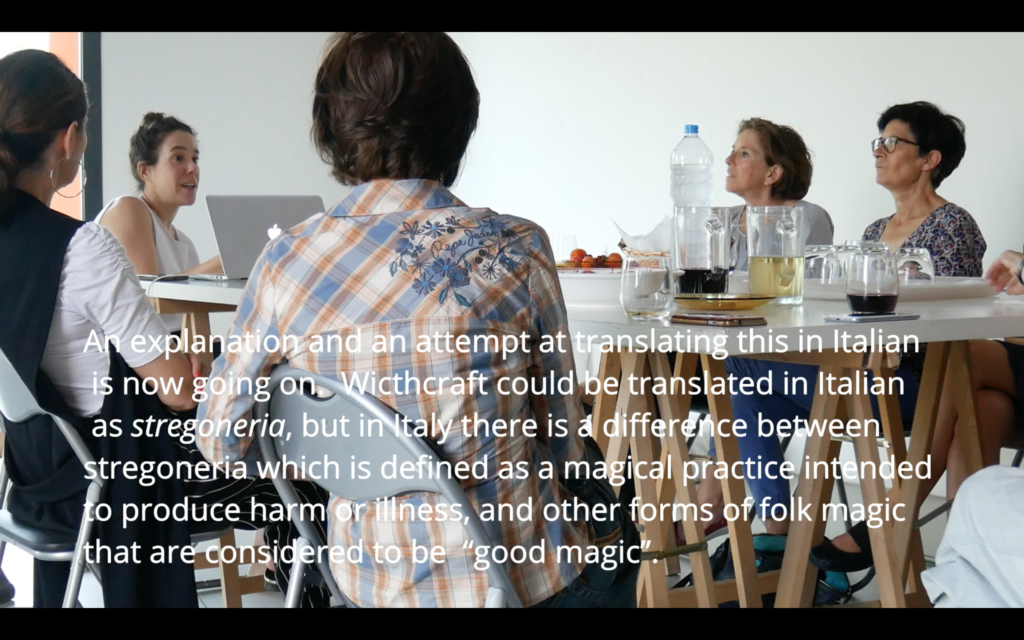24 Apr 2019
Interview
MARIE-ANDRÉE GODIN: MAGIC AND POSTCAPITALISM
Marie-Andrée Godin (1986, Canada) is a visual artist based in Finland. She has an M.F.A from Laval university and is now conducting a doctoral research in arts on Magic and Postcapitalism at Aalto University, Finland. She is currently working at HIAP studios, until January 2020.

Marie-Andrée Godin, While the Internet Plays Hard to Get, I Can Imagine the Waves Forming Drawings of Revolutionary Aesthetic – WWW³ (WORLD WIDE WEB/ WILD WO.MEN WITCHES/ WORLD WITHOUT WORK), Performance, 2018. Photo by the artist.
AA: Your work and your research links feminism to class politics and the emergence of capitalism through witchcraft. How did your interest in these topics first develop?
M-AG: Around 2015, I guess, there was a rising of witchcraft related feminist expressions in popular and artistic culture -that just kept growing since then. At first, I didn’t know so much about the historical links between feminism and witches, but I felt a connection to my practice. At the time I was doing mostly collages, and rocks. Hahaha! I would make collages with images of rocky landscapes and mountains, and caves, and stones, and paint real rocks -some of them quite big and heavy- with glitters and mix them with quartz stones or more esoteric stones. There was something in nature and artifice relationship within those collages and those rocky sculpture that seemed to relate to witchcraft. At that point, I was looking to integrate more of my feminist beliefs in my art practice, and the figure of the witch came in handy. So, I focused my master degree’s research one the figure of the witch, as a feminist figure.
This is when I really came to see that the disenchantment of the world – of which witch hunts and colonization of the so-called “New-World” were the most violent and efficient manifestations – have mainly served the interests of capitalism and patriarchy- and now I also see clearly how it led us to the ecological collapse we are now facing and the sixth mass extinction we are now witnessing.
Early on, I encountered the thoughts of Sylvia Federici, which have been a pretty important pillar for my work. In Caliban and the witch: Women, the Body, and Primitive Accumulation (2004) her hypothesis is that, despite Marx and the general admission of a slow process of the advent of capitalism that would then gain its full form in the nineteenth century, the horrible European witch hunts matched the transition from a feudal regime to a capitalist one. This transition was effective through, for one thing, the privatization of communal lands and the expropriation of peasantry, which led to the new obligation for people who were formerly serfs to become “salaried workers”. This, of course – and this is still the case today if we think of austerity measures – impacted women even more than it impacted men. If in the 14th century women received half of a man’s pay, by the 16th century, they would receive a third. It also brought a more advanced form of oppressions on the bodies of women, who then became the main producers of the labor force (or power labor), by given birth to it (through birth labour) and caring for it (through domestic labour).
Thenceforward, women have been quasi-entirely excluded from the social spaces and confined to the domestic ones. This domestication was accompanied by a control over their bodies and their reproductive functions. Rulers of the new mercantile capitalism states realized that the number of citizens was the main element that determined a nation’s wealth: more people equal more workforce and more armed force. This particular demographic preoccupation is, according to Federici, the main reasons for the witch hunts, since the witches were the one people would turn to, to prevent pregnancy, either to happen or to be carried to term.
Federici also points out that capitalism needed to “disenchant” the world to achieve efficiency and predict the pace of capital production and accumulation.
It is following this that I put forward an apparently simplistic and naïve idea with my research: if magic and witchcraft have a link to the pre-capitalist world, they might as well be a tool for achieving a post-capitalist one.

Marie-Andrée Godin, While the Internet Plays Hard to Get, I Can Imagine the Waves Forming Drawings of Revolutionary Aesthetic – WWW³ (WORLD WIDE WEB/ WILD WO.MEN WITCHES/ WORLD WITHOUT WORK), Performance, 2018. Photo by the artist.
AA: How are your research and your artistic work linked, and within which field do ideas usually first emerge?
M-AG: I don’t see them as two different things. There is a fluid relationship between the thinking and the doing for me. I create my pieces on the basis of what I discover or learn through all the theoretical research, but I feel like, somehow, the theory is part of the creation. Then, the pieces can refer directly or not to certain knowledge or ideas, or sometimes it becomes a pretext to discuss that certain knowledge or idea. Sometimes it’s very clear to the viewer where the piece comes from, sometimes not that much, but it is always is created on the basis of what I have uncovered through my research. My installations and performances aim to be spaces where those ideas can be shared through lectures, discussions, round tables, or other forms of sharing it, in an attempt to reclaim some power as a collectivity.
AA: Performance can be seen as a ritualistic practice, linking it as such to notions of magic and witchcraft, and words can be seen as spells. Have you ever consciously chosen your media to support ideas related to magic?
M-AG: I know is often put forward like this, or it has been, for instance in the 70’s and 80’s – I guess I am thinking of Mary Beth Edelson, maybe, and others like her – or that the very notion of performance is also link to archaic rituals and so on. But perhaps I don’t make the link so clearly. I mean, I see the performativity of magic, or even I see that magic is performativity…
I like Starhawk, for instance, who says in Dreaming the Dark. Magic, Sex and Politics (1992) that magic is: “the art of changing consciousness at will”. She adds, “According to this conception, magic includes politics, which aims at the change of consciousness and, consequently, and therefore conduct change itself. […] Magic can be very prosaic. A leaflet, a lawsuit, a demonstration or a strike can change the consciences.[1]”
AA: There is so much knowledge that has traditionally been passed on through generations of women; is this witchcraft?
M-AG: Maybe! Probably! But there is also a lot of knowledge that has been lost… I want us to claim it back!
AA: Do you feel that maybe the change that societies need, is a shift towards communal thinking and shared knowledge? A lot of thinkers seem to currently place hope in communities.
M-AG: YES! Definitely! That is a question that could get a very long answer from me, but to make it short, I will come back to Federici’s thesis in Caliban and the Witch. She clearly links the massive witch hunt of early modern Europe to the enclosure process, and other types of loss of the commons. To get back magic, for me, is to get back the commons. I mean, the violent repression of witchcraft meant the violent repression of solidarity between women, the loss of skill and know-how, the loss of autonomy regarding community self-care. It is also a way to reconnect with nature… I mean there is no nature and us. All is nature. And we don’t need to reconnect, we need to recognize that we are connected, and have always been. This is one of the great principle of witchcraft: the interconnexion of everything!
AA: Are you familiar with the work of Johannes Paul Raether and Jesse Jones, who also work with themes of witchcraft and post-capitalism? What other artists you believe share your ideas, whose work are you following?
M-AG: I am, yes!
I see at the moment that, in addition to a tradition of women and queers appropriating the figure of the witch in the art realm – as well as outside of it – in the 70’s and 80’s; and in addition to a strong contemporary comeback of this very empowering type of appropriation magic is also more and more perceived as a tool for political thinking, action and change within the art world itself. For instance, at the last Venice biennale one could both witness Jesse Jones’s piece Tremate! Tremate! (Tremble! Tremble!), where the witch dance was used as a “political myth for socialist-feminism” and the exhibition Il mondo magico curated by Cecilia Alemani in the Italian Pavilion. In regard of what interests me The reading/La sedute from Adelita Husni-Bey was the most revealing work comprised in the exhibition. The video-installation documents a Tarot workshop that took place with a group of teenagers in New York. The Tarot cards were designed by Husni-Bey as the following major arcanas: Extraction, Soil, The Ongoing End, Dirt, Vulnerability, Value, The Colony, Abstract Threat, Simulation, Real Threat. The reading was then discussed in relation to Standing Rock protests (where an Indigenous tribe fought to protect their land from an extraction company, which started in 2016), and in collaboration with the theorist, indigenous representative, or artist guests who came to talk about those topics to the teenagers to enlighten the reading.
I also very much appreciate the work of the Canadian queer artist AA Bronson. Mostly, lately, the work with Peter Hobbs that has been collected in the book Queer Spirits (2011). AA Bronson and Peter Hobbs have perform rituals to “invoke the homometaphysical” in four location, known to have been kinda non-mix men only places in New Orleans, Winnipeg, Governors Island and Fire Island in New York. In each of those places, they set-up a different Invocation. The book is amazing!
There is also duo Fastwürm, in Canada, has also been working quite a lot on this topic for decades. They really associate anti-capitalist thinking with witchcraft. And the French artist and filmmaker Camille Ducelier… And so many others…
AA: Who are your main literary influences?
M-AG: I don’t know that I have literary-literary influences. I mean I love literature, and it of course influence me in general, but I don’t link it so much with my visual work. Nevertheless, I feel that my research has a connection with speculative fiction (and speculative feminism, and all kinds of other SF figures, as Haraway puts it) and therefore a sort of kinship with science fiction too (another of Haraway’s SF). But I don’t have enough time to read SF as much as I would like hahaha! I still see how it can be very inspiring! It helps to imagine new narratives and open new possibilities. I also believe in traditional storytelling. I wish storytelling like those of the First nations, Metis and Inuits in Canada, and I guess the Sami here have their own too, would be more present to us.
I would say that in terms of thoughts – and not necessarily of literature – the writings of Donna Haraway, Starhawk and Federici, as I mention earlier, are very important to me. I would add to them Timothy Morton’s work, which is very inspiring for me!

Marie-Andrée Godin, While the Internet Plays Hard to Get, I Can Imagine the Waves Forming Drawings of Revolutionary Aesthetic – WWW³ (WORLD WIDE WEB/ WILD WO.MEN WITCHES/ WORLD WITHOUT WORK), Performance, 2018. Photo by the artist.
[1] STARHAWK, Rêver l’obscure, femmes, magie et politique, Paris, Cambourakis. Coll. Sorcières, 2015 (1982), p. 39. (Personal translation from the French edition. 2015)
Read more:
